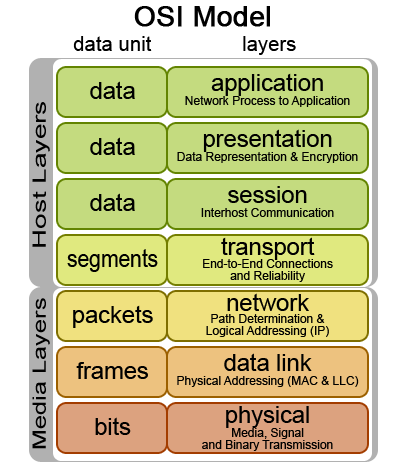资源说明:
# Stack Model Two models: [OSI](http://en.wikipedia.org/wiki/OSI_model) is abstract:  [TCP/IP Reference Model](http://en.wikipedia.org/wiki/TCP/IP_model) is intuitive:   "We reject: kings, presidents and voting. We believe in: rough consensus and running code." ~ [David D. Clark](http://en.wikipedia.org/wiki/David_D._Clark) # Internet Protocol Two protocols actively in use IPv4 and IPv6. Identical in function, slightly different implementations. IP properties: * Unreliable but simple * "Brick with a note" model * Addressing whole hosts  IPv4 may fragment and re-assemble packets. IPv6 does away with this in favor of [MTUPD](http://en.wikipedia.org/wiki/Path_MTU_Discovery). IP addresses may be spoofed. This is typically not an issue since routers can usually detect this. # ICMP/ICMPv6 * Sometimes considered at IP level and sometimes above it. * Used by hosts to communicate about the network. * Increasingly important for IPv6.  traceroute uses ICMP by sending packets with increasing TTL value and getting the response. # UDP Designed 6 years after TCP (1980). Similary to IP, but for direct use by applications: * Unreliable but simple * "Brick with a note" model * Addressing applications/services Adds the concept of "ports" (aka "service numbers", aka "AEN" - Another Eightbit Number). Individual applications/services may use well-defined ports. Source port is optional in IPv4.  Some uses of UDP include: * DNS * VPNs/Tunnels * Whenever reliability is not a priority * Whenever a higher-level protocol guarantees reliability # TCP Reliable protocol with the goal of delivering correct data "eventually". Main features include: * Connection-oriented communication * Data buffering * Reliability via positive acknowledgement * Congestion control  Includes lots of old-school assumptions and is optimized for slow and very unreliable networks. `TCP_NODELAY` socket option prevents unnecessary 200ms buffering. Do not tunnel TCP in TCP: congestion control on the low level will screw with congestion control on the top level. # HTTP Application level protocol implemented on top of TCP. Two versions actively supported: 1.0 and 1.1. Version 1.1 resulted in widespread adoption of apache, which resulted in widespread adoption of Linux. Text-based protocol: `` $ telnet localhost 80 GET / HTTP/1.0 Host: localhost HTTP/1.1 200 OK Server: nginx/1.0.5 Date: Wed, 15 Feb 2012 16:31:54 GMT Content-Type: text/html Content-Length: 172 Connection: close `` New features in HTTP/1.1: * Connection: keep-alive and Connection: close * Virtual hosts (apache first to provide wide-spread support) * Better caching semantics: ETags, Cache-Control * Vary header - modify cache key based on other headers * Range requests: allows to resume downloads * Compression: deflate, gzip, etc. * Pipelining: very poorly supported * Content negotiation using Accept-Charset, Accept-Language, etc. Many DoS attacks possible. One such attack is Slolaris: send requests to server very slowly. # Firewalls A firewall is a data filter. Can operate at any level. Most operate at IP or Transport. HTTP firewalls exist. Can filter on any combination of address/network, port, connection state. Can also provide translation: host A thinks it's talking to B when it's really talking to C. # "Click here to read more" * [Mobile IP]() - keeping the same address on different networks * [IP in IP tunnelling]() * [Multicast/Broadcast]() * [NAT]() * [Anycast]() * [BGP]() * Transports other than TCP/UDP
本源码包内暂不包含可直接显示的源代码文件,请下载源码包。
 English
English
